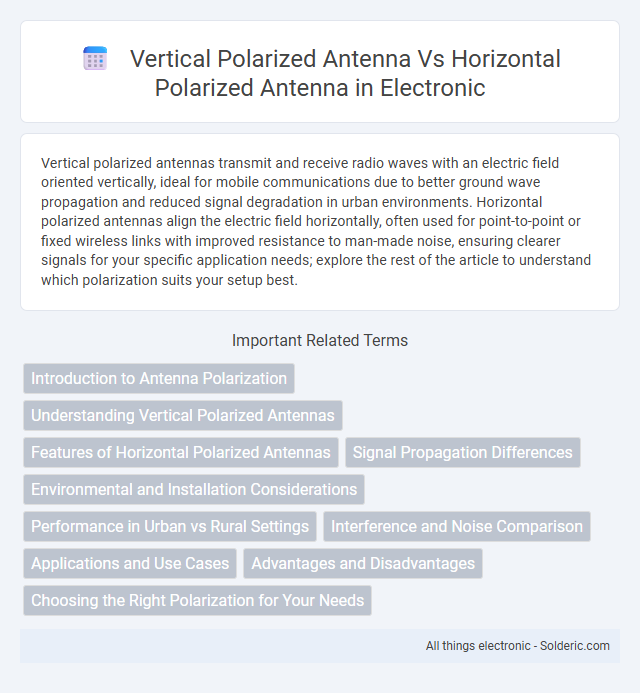Vertical polarized antennas transmit and receive radio waves with an electric field oriented vertically, ideal for mobile communications due to better ground wave propagation and reduced signal degradation in urban environments. Horizontal polarized antennas align the electric field horizontally, often used for point-to-point or fixed wireless links with improved resistance to man-made noise, ensuring clearer signals for your specific application needs; explore the rest of the article to understand which polarization suits your setup best.
Comparison Table
| Feature | Vertical Polarized Antenna | Horizontal Polarized Antenna |
|---|---|---|
| Polarization Direction | Electric field vertically aligned | Electric field horizontally aligned |
| Typical Applications | Mobile communications, vehicle antennas | TV broadcasting, point-to-point links |
| Signal Propagation | Better ground wave propagation | Less ground wave, better line-of-sight |
| Interference Susceptibility | More prone to man-made noise | Less prone to man-made noise |
| Mounting Orientation | Vertically mounted | Horizontally mounted |
| Polarization Loss | Minimal when aligned with vertical polarization | Minimal when aligned with horizontal polarization |
| Weather Impact | Less affected by rain scattering | More affected by rain and obstacles |
Introduction to Antenna Polarization
Antenna polarization refers to the orientation of the electric field of the radiated radio wave, with vertical polarization aligning the electric field perpendicular to the Earth's surface and horizontal polarization aligning it parallel. Vertical polarized antennas are commonly used in mobile and vehicular communications due to their better performance in multipath environments and easier omnidirectional coverage. Horizontal polarized antennas often provide improved range and are preferred in point-to-point communications where line-of-sight conditions dominate.
Understanding Vertical Polarized Antennas
Vertical polarized antennas radiate electromagnetic waves with the electric field oriented perpendicular to the earth's surface, making them ideal for ground wave propagation and urban environments where signals reflect off buildings. These antennas offer omnidirectional coverage in the horizontal plane, ensuring your communication maintains consistency over varied terrains and obstacles. Understanding the polarization alignment with the receiver is crucial for maximizing signal strength and minimizing loss in wireless networks.
Features of Horizontal Polarized Antennas
Horizontal polarized antennas feature radiation patterns oriented parallel to the Earth's surface, minimizing signal degradation caused by ground reflections and providing better propagation over long distances in open environments. These antennas typically exhibit improved performance in environments with fewer obstacles, reducing multipath interference and enhancing signal clarity in urban or suburban areas. Horizontal polarization is often preferred for point-to-point communication links, as it matches the polarization of many terrestrial communication systems and helps maintain signal integrity.
Signal Propagation Differences
Vertical polarized antennas exhibit radiation patterns optimal for ground wave propagation over uneven terrain, enhancing signal strength in urban and rural environments by reducing multipath interference. Horizontal polarized antennas typically provide better performance for long-distance line-of-sight links due to lower signal attenuation through foliage and improved reflection characteristics over flat surfaces like water. Differences in polarization directly affect signal penetration, reflection, and diffraction, making vertical polarization favorable for mobile communications while horizontal polarization suits fixed point-to-point transmissions.
Environmental and Installation Considerations
Vertical polarized antennas offer better performance in urban environments with dense obstacles due to their ability to propagate signals over and around objects more effectively. Horizontal polarized antennas are preferred in open, flat terrains where ground reflections can enhance signal strength and reduce interference. Installation of vertical antennas tends to be simpler on rooftops and poles, while horizontal antennas often require larger mounting space and precise alignment for optimal polarization.
Performance in Urban vs Rural Settings
Vertical polarized antennas often perform better in urban settings due to their ability to penetrate buildings and navigate multipath reflections, ensuring more reliable signal reception. Horizontal polarized antennas tend to excel in rural areas where line-of-sight communication is predominant, providing longer range and reduced signal degradation over open terrain. The choice between vertical and horizontal polarization significantly impacts wireless system efficiency based on environmental characteristics and propagation challenges.
Interference and Noise Comparison
Vertical polarized antennas generally experience less interference from man-made noise sources like power lines and industrial equipment, which tend to emit horizontally polarized noise, resulting in improved signal clarity in urban environments. Horizontal polarized antennas often face higher levels of noise and interference in such areas, but they can benefit from reduced multipath fading in open rural settings. Choosing the appropriate polarization depends on balancing interference levels with environmental factors and the specific communication application's propagation characteristics.
Applications and Use Cases
Vertical polarized antennas are commonly used in mobile communication systems, such as cellular networks and vehicle-mounted radios, because their polarization matches the vertical orientation of most antennas on handheld and vehicle devices. Horizontal polarized antennas are preferred in point-to-point microwave links and broadcast television, where signal reflections from the Earth's surface require horizontal polarization for optimal reception. Your choice between vertical and horizontal polarization depends on the specific application environment and the orientation of the transmitting and receiving antennas to minimize signal loss and interference.
Advantages and Disadvantages
Vertical polarized antennas offer better ground wave propagation and are ideal for mobile communications due to their omnidirectional radiation pattern, but they are more susceptible to man-made noise and signal interference from vertical structures. Horizontal polarized antennas provide improved signal penetration through obstacles and reduced noise levels, making them suitable for point-to-point communication, though their directional nature limits coverage area. Choosing between vertical and horizontal polarization depends on the specific application requirements, including environment, range, and interference considerations.
Choosing the Right Polarization for Your Needs
Vertical polarized antennas are ideal for mobile communications and ground wave propagation due to their ability to penetrate obstacles and maintain signal strength over uneven terrain. Horizontal polarized antennas reduce noise and interference in long-distance point-to-point links, making them suitable for fixed installations requiring stable, high-quality connections. Choosing the right polarization for your needs depends on the environment and communication range, ensuring optimal signal clarity and performance.
vertical polarized antenna vs horizontal polarized antenna Infographic

 solderic.com
solderic.com